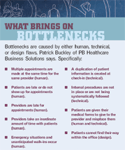Article
Patient traffic optimized by efficient practice design
Keeping patient traffic moving smoothly through your practice starts with realistic scheduling.

Key Points

So, the next time Laura Green* had an appointment with Dr. B, she scheduled the first appointment of the day: 9 a.m.
"Encouragingly, I met the doctor in the parking lot, and we walked into the office together," she says. But, to Green's surprise, she wasn't called into the exam room until 9:30, and Dr. B. didn't see her until 9:40. The next year, Green switched to another doctor-she decided it would be best not to see a physician who was already 40 minutes behind when he saw his first patient.

"In an ideal world, the patient flow process should be predictable," says Judy Capko, practice management consultant with Capko & Co. in Thousand Oaks, California, and the author of Secrets of the Best Run Practices. "This can be accomplished when a practice reflects on its problems in an honest way and seeks solutions to those problems, rather than yielding to the temptation to make excuses and expect patients to just cope with delays."

Smooth patient flow, in addition to being a sure-fire patient-pleaser, makes for a happier, less stressed staff, and reduces the need for crisis management and costly overtime.
HOW TO IDENTIFY BOTTLENECKS

Human problems, including overlapping appointments and patient and physician lateness, tend to have cumulative effects, says Judy Bee, a consultant with Practice Performance Group in La Jolla, California. Patients who arrive late usually have forms to fill out, so the medical assistant can't complete their workups in time for them to be ready when the physician enters the exam room. Some physicians then go into the office to catch up on dictation and make phone calls. In the meantime, the waiting room gets jammed, and the ensuing situation chips away at patient satisfaction.
Bee also sees overlapping responsibilities as a key reason for patient bottlenecks. "When a clinical person, such as a medical assistant, is also responsible for responding to patient telephone messages and tracking test results out, they can't move patients in and out of the exam room," she says.
To pinpoint process failures that are the primary causes of patient flow problems, Buckley suggests selecting a few patients and tracking time from "patient in" to "patient out." You'll probably find that the "80/20 rule" applies here, Buckley says; that is, a large percentage of snags are attributable to a small percentage of inter-office processes.





